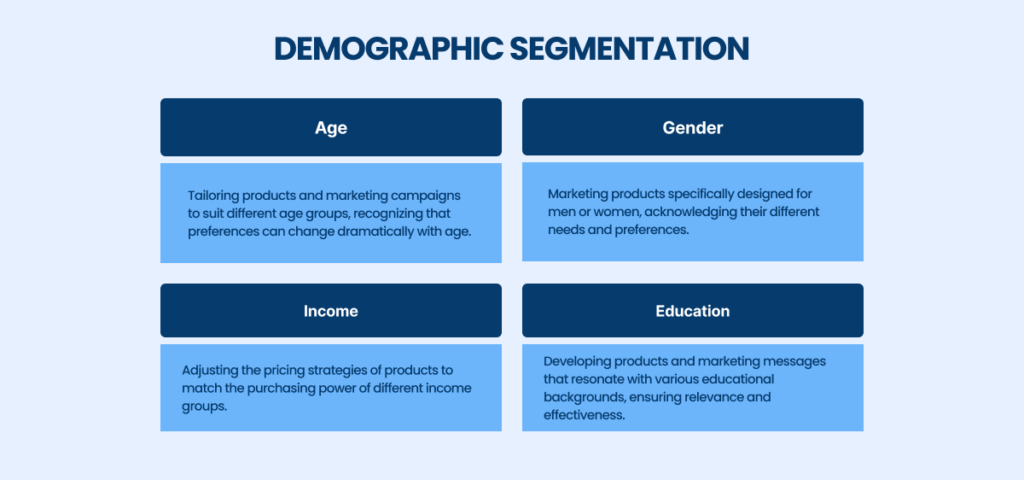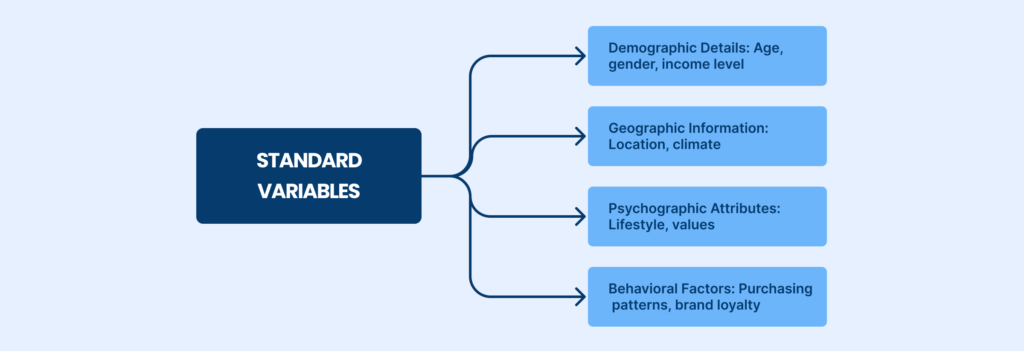Standing out and making a meaningful connection is a challenge.
Marketing segmentation is dividing your target market into smaller, more manageable groups based on shared characteristics.
80% of companies that use market segmentation report increased sales.

By understanding these segments’ unique needs, preferences, and behaviors, you can tailor your marketing efforts to deliver personalized messages that resonate deeply.
A specialized Fractional CMO Agency will leverage this detailed segmentation to position your brand strategically.
Moreover, it can ensure that marketing strategies are practical and efficient, focusing resources where they will generate the highest return on investment.
Let’s explore marketing segmentation more deeply and discover how it can help you optimize your campaigns and drive exceptional results.
What is Market Segmentation?
80% of consumers are likelier to engage with a brand that offers personalized experiences. This highlights the importance of segmenting your audience to deliver customized marketing messages.
Following that, market segmentation is dividing a broad consumer or business market, usually consisting of existing and potential customers, into sub-groups of consumers (known as segments) based on shared characteristics.
This approach is fundamental in market segmentation analysis as it involves breaking down large, heterogeneous markets into clearer and more manageable segments that can be targeted with specific marketing strategies.
The importance of how to do market segmentation analysis cannot be overstated. Companies can tailor their strategies to these groups’ specific needs and desires by categorizing the market into manageable divisions.
Types of Market Segmentation
Market segmentation is a powerful tool in the arsenal of marketers, allowing them to tailor their approaches to distinct groups within a broader market.
Understanding the various types of market segmentation can help businesses enhance their marketing campaigns, improve customer acquisition, and achieve competitive differentiation.
Demographic Segmentation
Demographic segmentation involves dividing a market based on variables such as age, gender, income, and education.
This form of segmentation provides a quick and often cost-effective way to target customers because demographic information is relatively easy to obtain and measure.
Age, Gender, Income, Education

Businesses leveraging demographic segmentation can benefit from consulting with market segmentation companies or using services like a fractional CMO to refine their approach and ensure their marketing strategies effectively align with demographic trends.
Geographic Segmentation
Geographic segmentation divides the market based on location, such as regions, cities, or climates. This type of segmentation helps companies tailor their products and marketing efforts to geographic differences in needs and preferences.
Regions, Cities, Climate
- Regions: Adapting products and marketing messages to fit the cultural and social norms of different regions.
- Cities: Targeting urban versus rural populations with different marketing tactics and product offerings.
- Climate: Offering products that are specific to the climate of a region, such as winter gear in colder areas and cooling systems in warmer regions.
An omnichannel marketing strategy is particularly effective when combined with geographic segmentation, as it allows businesses to reach the right customer segments through the most appropriate channels based on location.
Psychographic Segmentation
Psychographic segmentation considers the psychological aspects of consumer behavior, which include lifestyles, values, and interests.
This segmentation is more subjective than demographic or geographic segmentation but can lead to a deeper understanding of consumers.
Lifestyle, Values, Interests
- Lifestyle: Segmenting based on lifestyle choices, such as eco-friendly or luxury preferences, which can influence buying decisions.
- Values: Understanding what core values motivate consumer behavior, such as sustainability or innovation, to align products and brands with these values.
- Interests: Catering to specific consumer interests, whether in sports, arts, technology, or other areas, to enhance relevance and engagement.
Businesses can perform in-depth psychographic segmentation using consumer behavior analytics to craft highly targeted marketing strategies.
Behavioral Segmentation
Behavioral segmentation divides the market based on consumer interactions with a brand and their behavior during the buying process.
This segmentation is crucial for developing personalized marketing strategies that enhance customer engagement and retention.
Purchasing Behaviors, User Status, Loyalty
- Purchasing Behaviors: Analyzing past purchase behaviors to predict future buying patterns and personalize marketing messages accordingly.
- User Status: Identifying if consumers are first-time buyers, regular users, or potential customers to tailor marketing communications.
- Loyalty: Segmenting based on consumer loyalty levels, targeting loyal customers with rewards, and developing strategies to elevate the loyalty of newer or less engaged customers.
Integrating marketing solutions that leverage behavioral data can significantly optimize the effectiveness of marketing campaigns and help maintain competitive advantage.
By understanding and applying these types of market segmentation, businesses can effectively allocate their resources and design compelling, customized experiences that resonate with distinct customer segments.
Whether through employing a fractional CMO for strategic insights or utilizing integrated marketing solutions, effective market segmentation is key to achieving precise targeting and successful marketing outcomes.
Conducting Market Segmentation Analysis
Market segmentation analysis is a critical process for businesses aiming to target their marketing efforts more effectively.
This analysis involves several key steps: identifying segmentation variables, collecting market data, and analyzing market segments.
Each step is pivotal for crafting a comprehensive market segmentation strategy that resonates with the target audience.
Identifying Segmentation Variables
The first step in market segmentation analysis is identifying the most relevant segmentation variables. These variables are the criteria for dividing the broader market into smaller, more manageable segments.

Plotting the right variables is crucial for businesses, especially those utilizing a fractional CMO or CMO as a service.
A fractional CMO can provide the expertise needed to select variables that align with the company’s strategic goals. This ensures that the segmentation captures the diversity within the target market and aligns with the brand’s core values and marketing objectives.
This strategic input optimizes lead generation and enhances lifecycle marketing automation by focusing efforts on the most promising market segments.
Collecting Market Data
Once the segmentation variables are set, the next step is gathering the data needed to segment the market.
This data collection can be achieved through various methods, offering different insights and benefits.
Interviews
Interviews allow for a deeper dive into the customer’s psyche, providing nuanced insights that surveys might not capture. This method is invaluable for understanding potential customers’ motivations, emotions, and decision-making processes.
Interviews can be especially beneficial when detailed, personal feedback is necessary to shape the market segmentation strategy.
Consumer Data Analytics
Consumer data analytics involves analyzing existing data from customer interactions and engagements. This might include data from website visits, social media interactions, purchase histories, and customer loyalty programs.
Businesses can use data-driven personalization techniques to identify patterns and trends that inform more accurate segmentation.
Source: eMarketer
This efficient method often provides a broad overview of customer behavior and market dynamics.
Implementing Segmentation in Marketing Strategy
Implementing effective market segmentation strategies is crucial for businesses aiming to optimize their marketing efforts and enhance customer engagement.
Companies can significantly improve their lead generation optimization and brand loyalty by tailoring marketing messages, differentiating products, and strategizing distribution.
Tailoring Marketing Messages
The success of any marketing campaign largely depends on how well the message resonates with the target audience.
By utilizing insights from market segmentation analysis, businesses can tailor their marketing communications to meet the unique needs and preferences of different customer segments.
Customized Promotions
Customized promotions are designed to appeal directly to the needs and desires of a specific segment.
For instance, if market research indicates a price-sensitive segment, businesses might offer special discounts or bundled deals to attract that demographic.
Conversely, for a segment interested in premium products, promotions might focus on quality and exclusivity rather than price reductions.
Customized promotions not only increase the effectiveness of marketing campaigns but also help build customer loyalty by showing that the business understands and values the unique preferences of its customer base.
Targeted Advertising
Targeted advertising involves creating ads specifically designed to speak to the distinct characteristics of each segment based on demographic data and other segmentation insights. This can include varying the advertising content, images, and even the platforms used to reach different segments.

For example, younger demographics might be more effectively reached through social media platforms like Instagram or Snapchat. In contrast, older segments might respond better to email campaigns or traditional media such as television.
The goal is to ensure that each advertisement is seen by a segment that will find the message most relevant, thereby increasing the efficiency of advertising spend and improving overall campaign performance.
Product Differentiation and Positioning
In a competitive market, the ability to differentiate your products and correctly position them can be a significant advantage.
Market segmentation analysis provides the necessary insights to align product offerings with the specific needs of different market segments.
Aligning Product Offers with Segment Needs
This strategy involves modifying existing products or creating new products to meet the needs of different segments better.
For example, a food company might introduce a low-sugar version of its popular snack for health-conscious consumers or a tech company might offer advanced features in its products for tech-savvy users.
By aligning product offerings with segment needs, businesses can effectively meet customer expectations and enhance satisfaction, boosting customer retention and loyalty.
Distribution Strategies
The choice of distribution channels plays a crucial role in the success of market segmentation strategies.
Effective channel selection and comprehensive market coverage are essential to ensure that products are accessible to each targeted segment.
Channel Selection
Choosing the right distribution channels is vital for reaching the intended segments. For instance, luxury products are best sold through high-end retailers or exclusive online platforms to maintain the brand’s premium image.
Source: Data Report
In contrast, mass-market products may achieve better coverage through supermarkets and e-commerce sites.
The decision on which channels to use should consider where the target customers are most likely to shop and their shopping behaviors, which can be uncovered through detailed market segmentation analysis.
Market Coverage
Ensuring adequate market coverage means making sure that the products are available where and when the target segments need them. This might involve expanding into new geographic areas, increasing online presence, or enhancing supply chain capabilities to better serve remote areas.
Effective market coverage ensures that all potential customers within a segment have easy access to the products, thereby maximizing sales opportunities and supporting sustained business growth.
By implementing these sophisticated market segmentation strategies, businesses can ensure that their marketing efforts are more focused and efficient.
Partner with [A] Growth Agency for Your Market Segmentation Analysis
In the fast-paced world of business, data is your compass.
By harnessing the power of marketing analysis, you can confidently navigate the complexities of the marketplace.
From understanding customer behavior to measuring campaign effectiveness, data-driven insights are the key to making informed decisions and achieving sustainable growth.
[A] Growth Agency will guide you in the way.
Excellence is our standard. We cultivate a team of ‘A players’ – top-tier talents who bring passion and expertise to every challenge.
Growth isn’t just what we offer; it’s who we are. It’s embedded in our DNA and drives everything we do.
If this is what you are in search of, then go ahead.

